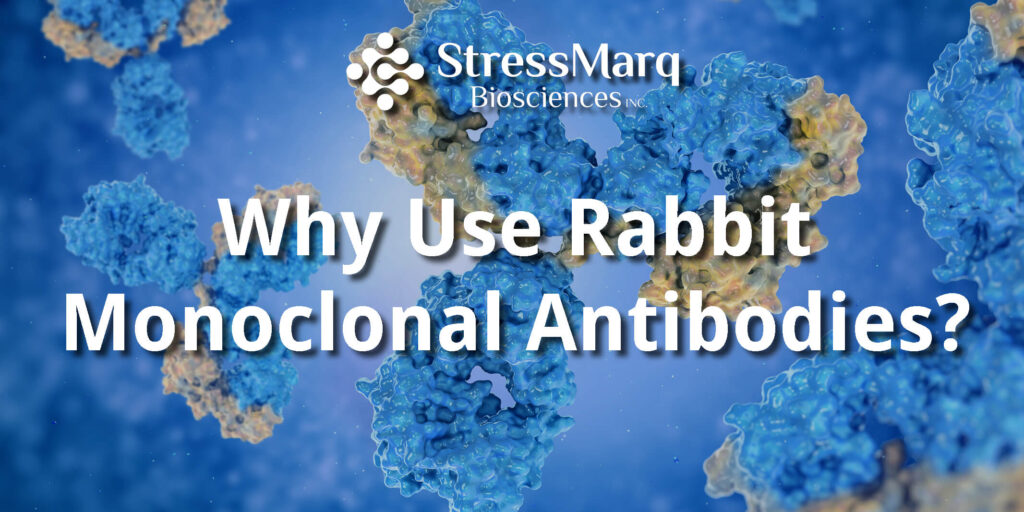How Can Rabbit Monoclonal Antibodies Benefit Your Research?
Monoclonal antibodies are widely used for scientific research since they demonstrate superior specificity and improved lot-to-lot reproducibility compared to polyclonals. While monoclonal antibodies have historically been produced in mice using the hybridoma method first described by Köhler and Milstein in 1975, rabbit monoclonal antibodies are becoming increasingly popular1,2. As well as being suitable for any immunostaining application where other antibody formats are currently used, rabbit monoclonal antibodies are especially attractive as an alternative to using mouse monoclonals for IHC, where numerous studies have shown them to have consistently higher sensitivity3.
What are the advantages and disadvantages of using rabbit monoclonal antibodies?
Rabbit monoclonal antibodies are produced similarly to mouse monoclonals, whereby animals are immunized with the protein target of interest and allowed to develop an immune response. Spleen cells are then isolated and fused with myeloma partner cells, and the resulting hybridoma are screened to identify antigen-specific clones. Once the clones have been characterized in applications such as Western blot, ELISA and IHC, the best performing candidates are scaled up and purified.
One obvious advantage of using rabbits for hybridoma production relates to their size. Because a rabbit spleen contains many more B cells than a mouse spleen, the chances of finding a suitable clone for expansion are much greater. Rabbits also have a more diverse immune repertoire than mice, meaning they can produce highly specific antibodies against a much broader range of epitopes, even those demonstrating only subtle differences (e.g. post-translational modifications). This enhanced diversity is due to multiple factors, including a greater incidence of somatic gene conversion and somatic hypermutation compared to mice and the presence of longer complementarity determining regions (CDRs)4,5,6.
Further benefits of using rabbits to produce monoclonal antibodies are that rabbits show less immunodominance compared to mice (meaning they are less likely to preferentially generate antibodies against more dominantly immunogenic epitopes) and can often mount an immune response to targets such as peptides or small molecules that have little immunogenicity in murine hosts. Additionally, affinity maturation can continue for longer in rabbits, resulting in antibodies with higher affinity for their targets. Rabbit monoclonals also frequently recognize both human and mouse proteins, allowing the same antibody reagent to be used for studying material from both species.
A disadvantage of rabbit monoclonal antibodies is that they may sometimes be more expensive than the murine equivalents; this can be because fewer rabbit monoclonal antibodies are commercially available and may also result from mouse husbandry being easier and cheaper than rabbit husbandry. Moreover, unlike mouse antibodies, rabbit monoclonals exist as only one class (IgG), making them less amenable to multiplexing.
Supporting your research with high-quality rabbit monoclonal antibodies
Our product portfolio includes a growing number of competitively priced rabbit monoclonal antibodies to support your research. These include our highly popular anti-Alpha Synuclein (pSer129) (SMC-600) and anti-Tau (pSer202/ pThr205) (SMC-601) antibodies, both of which recognize the human and murine forms of their protein target. These are available conjugated to a wide range of fluorophores, enabling you to streamline your workflow with direct detection.
![Rabbit Anti-Tau Antibody (pSer202/ pThr205) [AH36] used in Immunohistochemistry (IHC) on Mouse Brain slice (SMC-601)](https://www.stressmarq.com/wp-content/uploads/SMC-601_Tau_Antibody_AH36_IHC_Mouse_Brain-slice_2.png)
Immunohistochemistry analysis using Rabbit Anti-Tau Monoclonal Antibody, Clone AH36 (SMC-601). Tissue: Brain slice. Species: Mouse. Primary Antibody: Rabbit Anti-Tau Monoclonal Antibody (SMC-601) at 1:500 for Overnight at 4C. Secondary Antibody: Anti-Rabbit IgG: AlexaFluor 488. Counterstain: DAPI at 1:1000 for 5 min. CA3 Region of P301SxUBQLN2 Tg mouse. IHC Protocol: 1. Post-fix brains in 4% PFA for 24 hours and put through a 10-30% sucrose gradient. 2. Section by cryostat at 10 uM thickness. 3. Fix in MeOH 15 min. 4. 3×10 min wash in PBS 1X. 5. Heat via microwave in 10mM Citrate Buffer, pH 6 for 4 min at power level 20. 6. Cool in solution for 20 min. 7. Wash 2×5 min in PBS. 8. Permeabilize in 0.5% Triton-X 100 in PBS 10 min. 9. Wash in PBS 10 min. 10. Block for 1 hour in 5% goat serum. 11. Incubate primary Ab (SMC-601 at 1:500) in blocking solution overnight at 4C. 12. Wash 3×10 min in PBS. 13. Incubate in secondary Ab Rb IgG Alexa-fluor 488. 14. Wash 3×10 min in PBS. 15. Incubate in DAPI 1:1000 for 5 min. 16. Wash 3×5 min. 17. Coverslip with Prolong-Gold. Courtesy of: Julia Gerson, University of Michigan.
- Continuous cultures of fused cells secreting antibody of predefined specificity, Köhler G and Milstein C, Nature. 1975 Aug 7;256(5517):495-7 2) https://blog.citeab.com/the-rabbits-are-taking-over/
- From rabbit antibody repertoires to rabbit monoclonal antibodies, Weber J et al, Exp Mol Med. 2017 Mar 24;49(3)
- Systematic Characterization and Comparative Analysis of the Rabbit Immunoglobulin Repertoire; Lavinder JJ et al, PLoS One. 2014 Jun 30;9(6)
- Rabbits transgenic for human IgG genes recapitulating rabbit B-cell biology to generate human antibodies of high specificity and affinity, Ros F et al, mAbs, 12:1, DOI: 10.1080/19420862.2020.1846900
- Advances in the Isolation of Specific Monoclonal Rabbit Antibodies, Zhang Z et al, Front Immunol. 2017 May 5;8:49


Leave a Reply